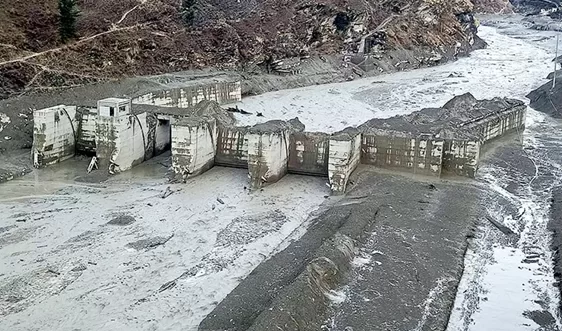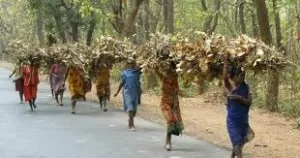The Ganga and the Himalaya are sacred to millions of Indians, yet these iconic entities of veneration face unjust and unethical treatment. Victor Mallet’s book River of Life, River of Death asks a pertinent question: “How can the Ganges be worshipped as a life-giving force by so many Indians and simultaneously abused by the same people?”
The brisk daily routine along the ghats in Varanasi, the riverfront steps leading to the banks of the Ganga, is the leitmotif of Indian social life. Despite the devotional attachment to “Ma Ganga”, the river’s waters have been dirtied and diverted extensively. Almost reaching a point of no return, the Ganga has become the most polluted river in the world.
The Ganga basin is one of the most diverse ecosystems in terms of geology, climate, vegetation, and aquatic life. Economically, this river and its basin contribute close to 40 per cent of India’s GDP and are one of the most densely populated riverine systems, supporting around 600 million people in 11 States. This majestic continental-scale river has lost so much of its vigour mainly because of damming and diversions, and consequently, its purpose. Out of the Ganga’s total length of 2,525 km in India, only 80 km flows freely as the river once did. The remainder of the river has been altered by reservoirs, barrages, tunnels, and canals, interrupting its flow regime and impacting its ecosystems and habitats. At one time, more than 300 dams were envisaged in the Ganga basin and its tributaries by the government of Uttarakhand.
This triggered many court cases and protests/public outrage about the cumulative impact of hydroelectric power plants (HEP) on the river and the overall ecology of the Ganga basin. Public protests between 2007 and 2010 led to the cancellation of three under-construction projects in Gangotri, the origin valley of Ganga, and subsequently, the entire area was declared as an eco-sensitive zone with the intent of preventing further dams and to protect the last pristine stretch of the Ganga.
On the other hand, the various action plans on Ganga conservation, until now, have focussed only on the cleaning of the river, and therefore, the conservation efforts have had limited results. It is widely known and accepted that the river cleans itself if allowed to flow freely. It was also known that the flow of the Ganga had been severely tampered with, which impacted its water quality. Still, when it came to including this aspect in policymaking, the government chose to ignore it because paying heed to it would mean cancelling hydropower projects on the Ganga and its tributaries.
Bhagirathi Eco-sensitive Zone
However, following public outrage, three under-construction hydropower projects on the last pristine stretch of the river, Gangotri to Uttarkashi, were cancelled in 2010, and the entire watershed was notified as the Bhagirathi Eco-sensitive Zone in 2012. The notification bans construction of hydropower plants on this stretch, thus making it the only place for Ganga darshan.
A new concept called “Ganga Rejuvenation” came up in 2014. On July 31 that year, the National Ganga River Basin Authority was transferred to the Water Resources Ministry from the Ministry of Environment, Forest and Climate Change (MoEFCC). With this move, the cleaning and rejuvenation of the Ganga assumed the character of a national priority. Rejuvenation meant making sure that the river flowed freely. Hence the need for aviralta (free flow without interruption) was highlighted as essential, with nirmalta (cleanliness) as a secondary goal. However, the government’s initiatives have not lived up to this promise, and policy flip-flops have undermined conservation efforts.
Supreme Court initiates inquiry into impact of HEPs
In 2012 the Wildlife Institute of India (WII) recommended cancelling 24 proposed dams in the Ganga basin, citing their potential for “irreversible impact on biodiversity”. Following the catastrophic flood in Kedarnath in 2013, the Supreme Court took suo motu cognisance of the disaster and gave directions for an inquiry into the impact of hydroelectric power projects on “environment and ecology” by an “expert body”.
After site visits and a thorough investigation, the expert body (called EB-1) that consisted of a team of scientists and government officials under Ravi Chopra concluded that both existing and under-construction dams had “a direct and an indirect role” in worsening the impact of the disaster.
A report by EB-1 supported the WII recommendation that the 24 proposed projects be cancelled and also called for the installation of early warning systems at all hydropower sites. The MoEFCC concurred with the conclusions drawn by the EB-1 report and its recommendations. In fact, in its December 2014 affidavit submitted to the Supreme Court, it accepted the conclusions of the EB-1 report, quoted previous reports with similar warnings, and even recommended a cumulative impact assessment and further hydrogeological studies.
Narrative shifts gears
The developers of six of the stayed dams intervened in the court case. Now, the narrative changed to the dams being “victims of the court’s stay order”, whereas the original case was about the damage that the dams were wreaking on the environment. Another committee, this time a four-member one, was formed to reconsider these six projects “as a cluster”. Although this committee acknowledged the need to review all clearances awarded before 2013, the government submitted to the Supreme Court that the six projects could proceed.
The contents of the original four-member committee report became public, forcing the government to withdraw its submission. But it formed another committee, called Expert Body 2 (EB-2), which was chaired, in a clear case of conflict of interest, by a member of the clearance group that approved some of the under-investigation HEPs. In fact, the majority of EB-2 members were engineers and government officials; the body even included the project proponent Uttarakhand Jal Vidyut Nigam.
The EB-2 report claimed that this expert body had been formed on a direction from the Supreme Court because the previous reports were unscientific. However, no such order was annexed to the report. For good reason, since no such order existed. This committee was formed with a pro-hydro bias and its purpose was to overrule the recommendations of EB-1, which had independent field experts who carefully surveyed the Ganga basin after the 2013 Kedarnath disaster.
EB-2 debunks EB-1 findings
The EB-2 report approved nearly all projects with some design tweaks. It ridiculed all the anti-hydro reports, debunked the WII report, and declared the conclusions of EB-1 to have been wrong.
EB-2 used some assessment models to assert that construction north of the MCT (Main Central Thrust along the continental fault line, where the Himalaya is still growing and thus vulnerable) would have no adverse impact; that human-made reservoirs did not impact seismicity; and that glacial lake outburst floods could be managed if the HEP allowed the flow of the flood.
It also said the people of Uttarakhand were delighted with HEPs, despite the protests against these projects that adversely affected livelihoods and led to sociocultural issues. The report claimed that natural disasters had nothing to do with any hydropower project. It asserted that there need be no fear of any mishap because HEPs were launched after thorough scientific analysis (a reference to environmental impact assessment, or EIA, reports funded by the project proponents themselves).
Scientific reports/journals state that the area north of the MCT is prone to landslides. (See report in Lithosphere, Volume 7, Issue No. 3 by K.D. Morell, M. Sandiford, C.P. Rajendran, K. Rajendran, A. Alimanovic, D. Fink, and J. Sanwal.) The example of the dam in Maharashtra over the Koyna river has shown that reservoir-triggered seismicity is a possibility that cannot be trifled with. Glacial flash floods carry huge loads of debris and are, therefore, not easy to manage. The most recent example of public outrage against HEPs in Uttarakhand was in Joshimath over the Tapovan Vishnugad project. That HEPs escalate the disaster impact manifold is well-established through several studies. EIAs are often in favour of HEPs but will not stand up to thorough scrutiny.
The government, however, did not concur with the EB-2 report. In fact, the ministry assigned with the task of “Ganga Rejuvenation” filed an affidavit in 2016 saying that none of the projects should be allowed.
This led to an apparent “inter-ministerial conflict”, which was purportedly resolved in 2019 when the Prime Minister’s Office, after a meeting chaired by the then Principal Secretary, Nripendra Mishra, intervened and stated the following:
- No new hydro-electric project shall be taken up on River Ganga and its tributaries in the State of Uttarakhand.
- All projects in which the work has not started on the ground shall be dropped.
- Concerning projects under construction, the seven projects reported to be 50 per cent complete, as recommended by the Ministry of Water Resources, may be taken up for further construction. [A three-member committee was formed to assess the on-ground status of these seven projects to confirm if they were 50 per cent complete, and the committee confirmed so.]
Subsequently in 2021, the government submitted an affidavit to the Supreme Court regarding a “consensus” on these seven projects but did not refer to the “policy decision” meeting of the PMO or the decisions taken therein.
Compensation sought for project cancellation
In August 2024, the case on the proposed hydroelectricity projects reopened in the Supreme Court with some of the concerned parties seeking compensation for project cancellation. One company even claimed that the stayed projects—Khirao Ganga and Bhyundar Ganga HEP projects—were in “advanced stages of construction”.
The government’s stance was presented as an “inter-ministerial conflict”, with the Ministry of Jal Shakti (Water Resources, River Development, Ganga Rejuvenation, and Drinking Water and Sanitation Ministries were merged into the Ministry of Jal Shakti in 2019 under the second Narendra Modi government) on the one side and the State government and the Environment and Power Ministries, apparently favouring the recommendations of EB-2, on the other. The government counsel, again, did not even refer to the policy decision taken at the highest level of the government, the PMO.
The court wondered “why only these 7” and “why only 7” projects were being allowed, whereas the EB-2 report recommended 28 projects. Another committee, this time headed by the Cabinet Secretary, was formed in August 2024 to re-examine these projects.
Interestingly, every time a decision to cancel these projects seems about to be taken, a committee is formed to reconsider it.
In an affidavit filed in November 2024, the Cabinet Secretary report cleared five new projects for construction, thereby dismissing inputs from the Ministries of Environment and Water Resources, which highlighted technical flaws in the EB-2 report and advised against relying on it. While playing the role of a “mediator” resolving differences between the camps, the Cabinet Secretary in his report submitted by the Environment Ministry in the court said: “There is indeed merit in each of these varying perspectives since there is genuine public interest in each of them viz. power generation, government revenue, environmental protection, prevention of disaster, etc. All of them are good things per se. The problem is not of good vs bad but of one good thing vs another.”
HEPs and natural disasters
To put things in perspective, in 2012, three small HEPs (of capacities 4.5 MW, 4.5 MW, and 9 MW) on the Asi Ganga were found to have escalated the impact of flash floods caused by a cloudburst in the Bhagirathi valley. Fifty lives were lost and the devastation was such that rescue workers could enter the valley only after three days.
In 2013, the flash floods in Kedarnath were found to have exacerbated the impact downstream of the Phata Byung and Singoli Bhatwari power projects, which were under construction. The muck deposited by the then under-construction Alaknanda HEP in Srinagar was found to be the reason why the town was buried in debris during the 2013 flash floods. In 2021, the Rishi Ganga flash flood claimed the lives of 200 workers at the Tapovan Vishnugad project. One wonders if this is the “good” the Cabinet Secretary refers to.
While globally hydropower projects are being decommissioned to save wildlife species and rivers, the Indian bureaucracy is still stuck in the reductionist mindset that sees destroying nature as acceptable for the sake of development. Can development exclude the people who are considered beneficiaries? Can development be at the cost of their lives?
In his report submitted in the court, the Cabinet Secretary echoed the stance of EB-2 and omitted the 2019 decision of the PMO and didid not even refer to the Principal Secretary’s meeting. Also, can a Cabinet Secretary overrule a Principal Secretary’s decision?
Five new projects approved in the Cabinet Secretary’s report are justified as being outside “GLOF” (glacial lake outburst flood) paths, but not all flash floods are glacial. The 2021 avalanche, the 2013 Bhagirathi Valley disaster, the land subsidence in Joshimath, the forest fires and landslides—all highlight the risks and collateral impact of large-scale infrastructure projects.
Heartbreaking videos of the disaster at the Tapovan Vishnugad project site revealed that the tragedy could have been averted had the EB-1 recommendation for installing early warning systems been followed. In 2022, the region experienced massive land subsidence in Joshimath located in the same valley, but the report steered clear of the hydropower project’s impact on the local ecology.
The Supreme Court’s 2013 suo motu response to the Kedarnath disaster initially focussed on assessing the implications of existing and under-construction hydropower projects in the Ganga basin. Over time, however, this scrutiny has disturbingly shifted into justifying new projects by setting up successive committees that are biased towards promoting hydropower projects.
On its part, the Uttarakhand government denies any link between disasters and hydropower projects. Its own disaster management report on landslides, however, says: “Several anthropogenic factors are also responsible for making this area conducive for mass movements. Encroachment into stream and river banks, steep cutting of slopes and left untreated, indiscriminate and unscientific construction of buildings, roads and dams are important anthropogenic activities….. during the construction phase of HEPs slope failure occurs through excavation of slope mass in the construction of roads, tunnel and other project appurtenances…. Blasting with dynamite recklessly for the construction of dams and tunnels has triggered thousands of landslides. When the first rain comes, these landslides fill the riverbed with rubble. Considering the extent of human interference, it is likely that the terrain sustainability is precariously balanced. A minor perturbation would have been enough to generate a cascading effect on the terrain instability.”
Feasibility of HEPs
As glaciers recede as a result of climate change, para-glacial sediments left behind are carried by increasingly frequent cloudbursts, causing debris-heavy flash floods. Science and past disasters confirm that no barrage can handle such massive debris displacement, making the idea of “disaster-ready” designs unrealistic and unscientific. This was borne out by the way the Singoli-Bhatwari and Phata Byung hydropower projects were wiped out in the 2013 Kedarnath disaster.
The question of feasibility of projects has two aspects. One is about the possibility of disasters and related impacts. The other is about the feasibility of a dam in itself. Climate change poses a significant risk to the feasibility of hydropower projects. A recent report by Climate Risk Horizons highlights that extreme weather events could either destroy or severely delay these projects, leading to cost escalation and other related financial implications. Additionally, retreating glaciers and growing glacial lakes reduce river flow in the long term, hindering estimated project output. A classic example is the Tapovan Vishnugad project.
In 2009, during the tunnel excavation, the tunnel boring machine (TBM) punctured an aquifer, resulting in the loss of massive amounts of water and the TBM getting stuck in the tunnel. In 2011, 2012, and 2013, cloudbursts during the monsoon caused continuous damage to the project barrage site and other infrastructure. As a result, the project completion was delayed by almost 10 years and rescheduled for 2022-23, and the cost escalated from Rs.2,900 crore to over Rs.13,000 crore. Further, in February 2021, the project was badly hit by a massive flood in the Rishi Ganga; the barrage was laden with debris, and the estimated cost for restoration was over Rs.1,500 crore. Imagine what the cost of electricity from this dam will be whenever, and if ever, it gets constructed.
Uttarakhand Action Plan on Climate Change Report, 2014
The Uttarakhand Action Plan on Climate Change Report of 2014 clearly visualised the impact of climate change vis-a-vis the development model pursued by the State. With regard to Himalayan region river systems, the report says: “The whole area is expected to experience an increase in precipitation in the 2030s scenario. The increase varies between 5 per cent and 20 per cent in most areas, with some areas of Jammu and Kashmir and Uttarakhand showing an increase of up to 50 per cent. The general impact of the increase in precipitation is expected to be an increase in the sediment yield.
“The increase in the sediment yield in the Himalayan region is up to 25 per cent, which can be detrimental to the existing water resources projects and has the potential to cause considerable damage to the environment. Detailed climate vulnerability assessments for Uttarakhand’s power sector are currently unavailable. However, it has been noted that a reduction in snow cover in the Himalayan glacial systems, from where perennial rivers such as the Ganga, Yamuna and Kali originate, will result in a decreased discharge in the rivers and hence lower generation, which will ultimately widen the power supply demand deficit in Uttarakhand. Extreme weather events are also likely to pose some threats to physical infrastructure assets.”
In conclusion, dams precipitate natural disasters, adversely impact biodiversity, and cause irreversible damage to the Himalaya. Their feasibility is highly questionable, given the exorbitant construction costs, the dangers posed to the dam structures, and the high cost of electricity generated. These are compounded by delays in construction caused by the challenging topography and frequent climate change events. The actual beneficiaries are politicians and contractors who profit from the construction contracts and disaster-related restoration work.
Unsustainable level of anthropogenic intervention
There is an unsustainable level of anthropogenic intervention across the approximately 35,000 sq km area of the Ganga basin in Uttarakhand. Projects such as road widening, rail network expansions, hydropower development, and increased tourism, all undertaken simultaneously, have left the region vulnerable to disasters.
Let alone its status as a civilisational symbol and a sacred entity for millions, even as India’s national river, the Ganga, has not been accorded the dignity granted to other national emblems, such as the national flag. The lifeline of the nation is now on the brink of collapse because of flawed government policies.
Preserving the Ganga is imperative for securing India’s future. Most importantly, one must remember that the name “Ganga” is derived from the root gam, meaning gach, that is, “to flow”. Thus, the uninterrupted full flow of the Ganga is non-negotiable, and without this, the rejuvenation of the Ganga is impossible.
(Mallika Bhanot is a member of Ganga Ahvaan, a citizen forum working for Himalaya-Ganga conservation and the Bhagirathi Eco-sensitive Zone monitoring committee. C.P. Rajendran is an Adjunct Professor at the National Institute of Advanced Studies, Bengaluru and author of the book The Rumbling Earth: The Story of Indian Earthquakes. Courtesy: Frontline, a fortnightly English language magazine published by The Hindu Group of publications headquartered in Chennai, India.)




